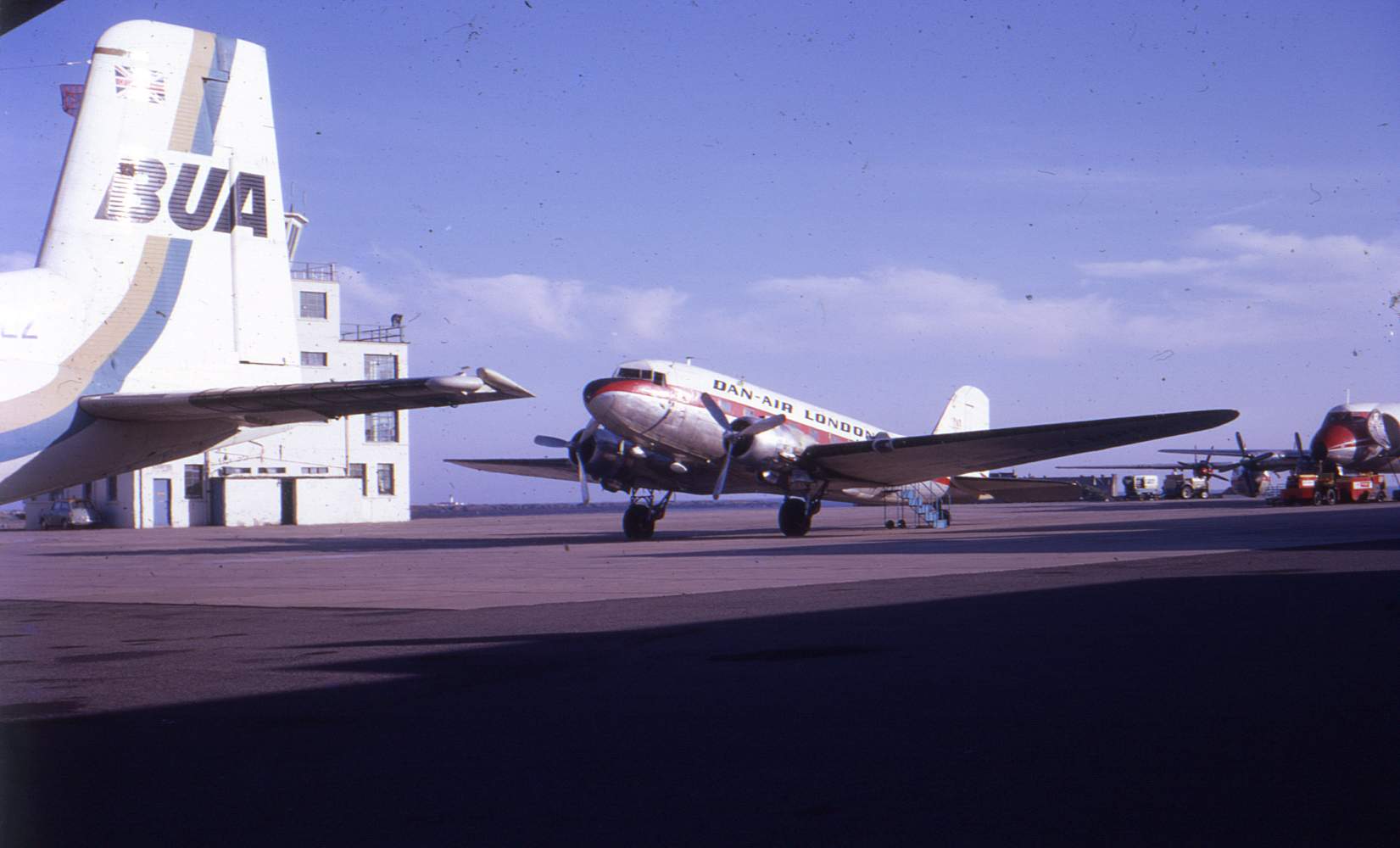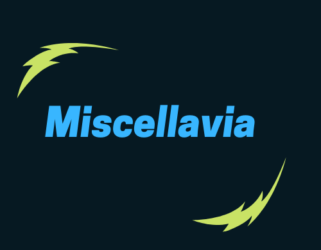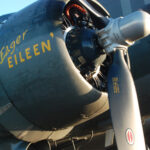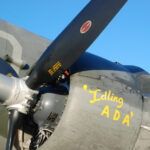Placid Lassie is another genuine D-Day veteran and has had a fascinating history in recent years too. Nick-named the ‘Union Jack Dak’ she was rescued from obscurity by financier James Lyle and his British engineer, Clive Edwards. Following a lightning revival from hulk to Oshkosh participant in 2010, she made the Atlantic crossing to Europe in 2014 and was ‘recognised’ as being ‘Placid Lassie’ by Dutch DC-3 expert Hans den Brok. Introductions were made between her owners and surviving original crew member Ed Tunison. The former radio operator, Ed and his son travelled to Belgium in September 2014 to see ‘Placid Lassie’ once again. Following Ed’s death in 2016, owner James Lyle set-up Placid Lassie as the charitable ‘Tunison Foundation’ which proved to be the inspiration for the entire D-Day Squadron in 2019.
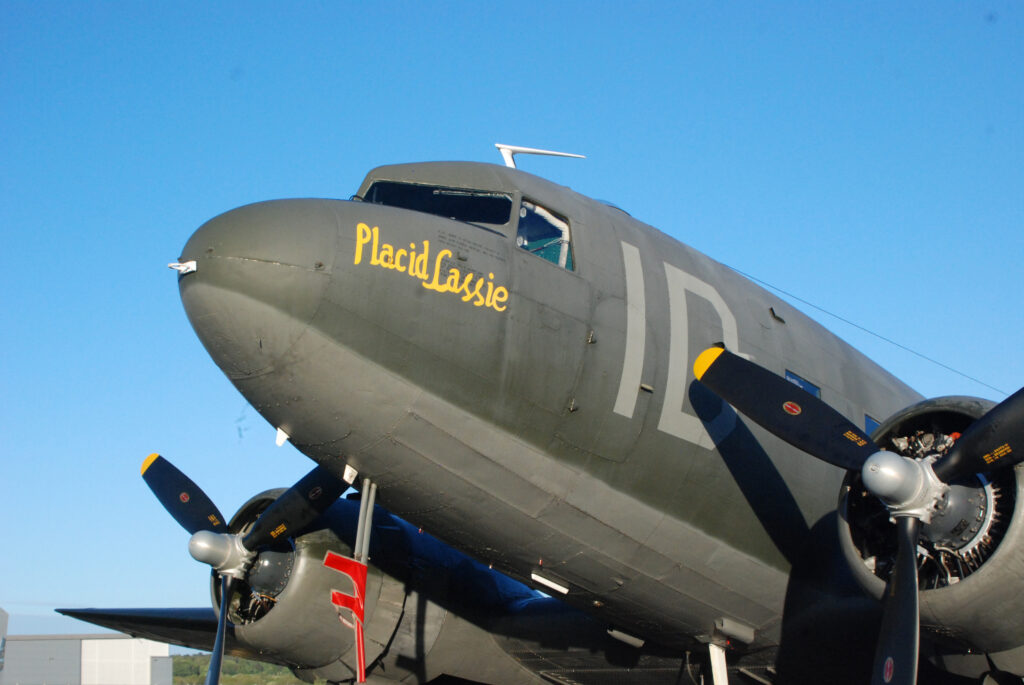
Placid Lassie was built at the Long Beach factory as a C-47A-40-DL for the USAAF under the contract AC-20669. With construction number 9926, she was delivered on 26th July 1943 as 42-24064 at a reputed cost of $109,683 (1). She was flown to Baer Field, Fort Wayne, Indiana on 29th July and on to the Daggett Air Base, Barstow, California on 31st. July. By 8th August, she was apparently at Bookley Field, Mobile, Alabama (2) before being allocated to her first unit, 74th Troop Carrier Squadron of 434th Troop Carrier Group later the same month. D-Day Doll, also with 434th TCG, had been allocated to the 72nd TCS and the two aircraft followed the same mobilisation route.
74th Troop Carrier squadron had been formed in February 1943 at Alliance, Nebraska. After early paratroop and glider towing operations in Colorado, the unit reportedly arrived at Baer Field on 7th September 1943. At 08:30 on 28th September , the 13 C-47s of 74th TCS departed to cross the Atlantic via the southern ferry route. They transited via west Palm Beach, Puerto Rico, British Guyana, Belem and Natal in Brazil, Ascension island to reach West Africa at Monrovia in Liberia. From here, they headed north to Dakar in Senegal, Marrakesh in Morocco and then out to the west of the neutral Iberian peninsula to reach St.Mawgan in Cornwall on 18th October (3). Although the southern route had been selected owing to autumn weather on the ‘Blue Spruce’ northern route, the 18-day transit was ten days longer than scheduled, also due to adverse weather.
(1) The Tunison Foundation quote this figure. USAAF data shows a cost of $109,696 during 1942, dropping to £92, 417 in 1943. By these standards, the C-47 appears to be a total bargain compared with Curtis Wright’s C-46 which had corresponding prices of $314,000 and $259,268. Source: AAF Statistical Digest pp 134 via www.ibiblio.org/hyperwar
(2) Information from the Tunison Foundation website www.tunisonfoundation.org.
(3) 74th TCS information is from the book by Carl W.Boswell, ‘The 74th TCS’ which is lodged with the Public Library in Bangor, Maine, and was accessed via www.digicom.bpl.lib.me.us
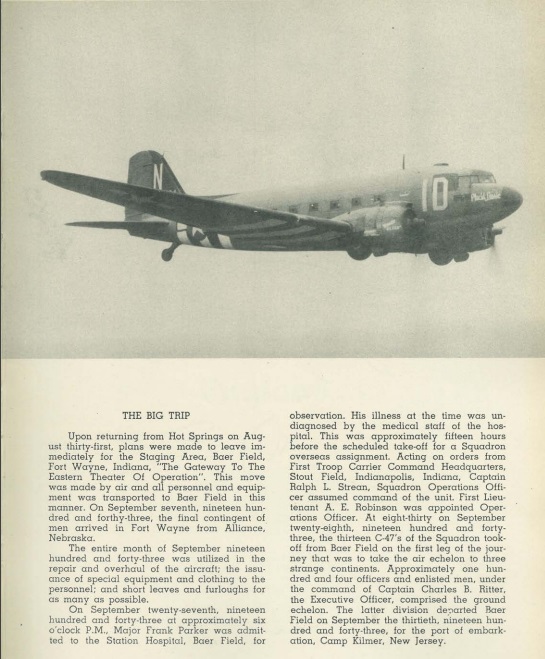
As part of IX Troop Carrier Command of the Ninth Air Force, 434th TCG was assigned to Station #488, Fullbeck, Lincolnshire, as part of 53rd Troop Carrier Wing. Placid Lassie was one of thirteen 74th TCS C-47s and carried the fuselage code ID. Her crew was already established with First Lt. Richard Lumm of Eustace, Florida, the Captain; Lt. Ralph C.Lundgren, the second pilot; First Lt. William E.Vaughn Jr of Nashville, Tennessee, the navigator; S/Sgt Edward Tunison of Penrod, Detroit, the radio operator and T/Sgt Eddie A.Apodaca of Albuquerque, New Mexico, the crew chief. Edward ‘Red’ Tunison gave the starboard engine its name, ‘Eager Eileen’, as a tribute to his wife, while the port engine ‘Idling Ada’, was named in honour of the crew chief’s wife. It’s not known what the two ladies thought of their fame/ notoriety.

The weather while at Fullbeck was poor and little or no flying took place from the wet and muddy air base. The 74th TCS moved to Welford on 11th November 1943 for two months training with the 101st Airborne on the nearby Salisbury Plain. Following parachute and glider-towing operations, 434th TCG returned to Fullbeck on 5th January 1944 for another short stay. The group moved to Aldermaston on 5th March 1944 as practice for D-Day was moved-up a notch. Aldermaston was a much better base for the 74th TCS and night formation flying and glider towing was practised.
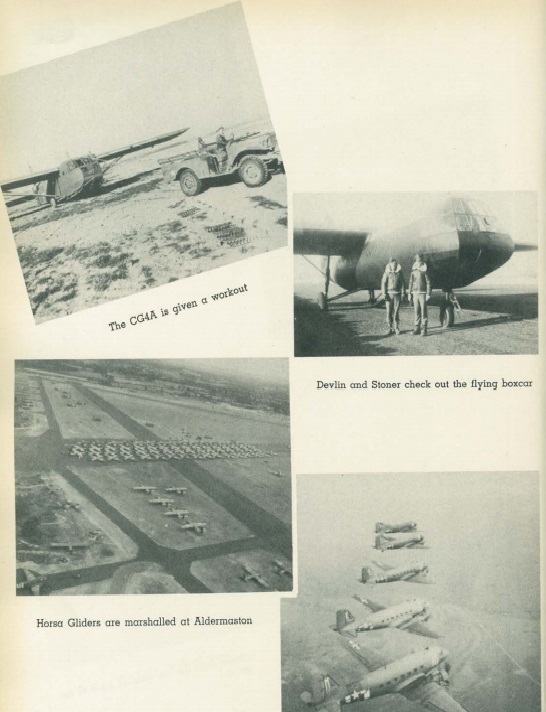
D-Day Operations:
On D-Day, June 6th, the 434th TCG Squadrons were in Mission Chicago Serial #27 carrying 155 101st Airborne troops in Waco CG-4A gliders. The eighteen tow aircraft of 74th were designated by chalk markings 33 to 50, the gliders with Chalks 37 to 50. Take-off from Aldermaston was around 01:19 with the 52 aircraft of ‘Chicago’ bound for Landing Zone ‘E’, adjacent to Drop Zone ‘C’, five kilometres inland from Utah Beach near the village of Hiesville. The 434th TCG arrived over the location a few minutes before the scheduled glider release at 04:00. One of the group’s aircraft, 43-15101, was lost and, reportedly, only 49 of the 52 gliders were operational at release. As the C-47s turned for home, the CG-4A gliders were experiencing difficulties: cloud obscured the moon and hampered the gliders manoeuvring to approach the 1.5km x 1km landing ground. Furthermore, the small fields of Normandy were bounded by high hedgerows which obstructed clear landings. The dew-covered grass also created slippery conditions which hampered the gliders stopping. Many glider occupants were injured.
Back at Aldermaston by around 05:30, both Placid Lassie and D-Day Doll were prepared for a second mission later that same evening. The 434th TCG provided 32 aircraft to tow Airspeed Horsas on Mission Keokuk, Serial 29, again destined for Landing Zone ‘E’ with an arrival time of 21:00. The 74th TCS C-47s and gliders carried the Chalks 25 to 32. The eight Horsas carried 157 troops plus vehicles, guns and armaments. The following morning, June 7th D+1, saw 50 434th TCG aircraft towing CG-4A gliders to Landing Zone ‘W’ to the south of Ste Mere Eglise.
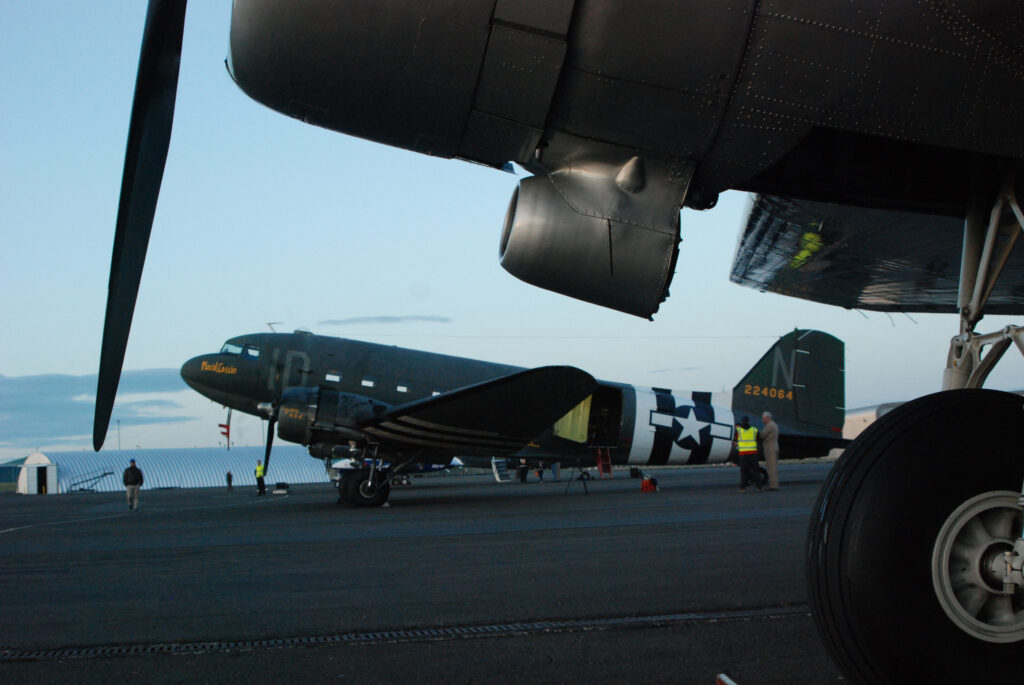
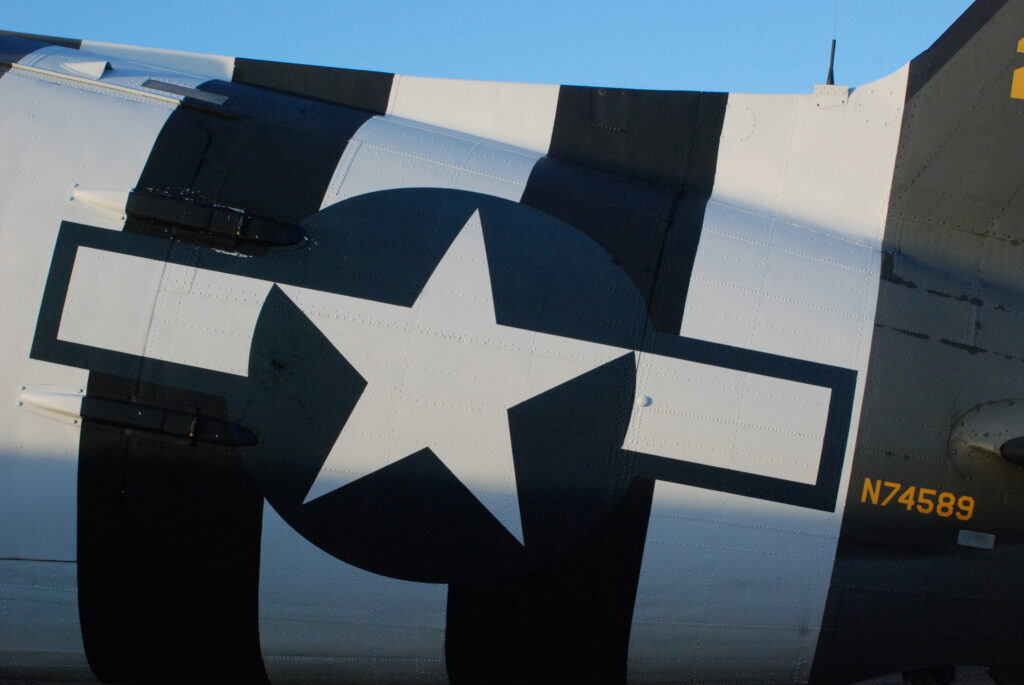
Subsequent operations saw Placid Lassie hauling gasoline, supplies and mail into Advanced Landing Grounds around the Cotentin Peninsula. As with the RAF’s 46 Group aircraft, homebound flights carried wounded personnel. The thread on D-Day Doll gives details of how the 434th Troop Carrier group prepared for further paratroop and glider operations on several occasions following the allied breakouit from the Normandy peninsula. In each case, the allied advance was sufficiently swift to make the airborne operation unnecessary. However, by September 1944, the allies considered that they were in a position to push across the Netherlands, crossing the nine major river bridges to spearhead them into Northern Germany. The move would be initiated by a joint US/ British/ Canadian and Polish airborne assault at Nijmegen and Arnhem. Operation Market garden was to involve the Aldermaston C-47 squadrons in both paratroop and glider functions. Unusually, as it was during a phase of low moonlight, the operation would be in full daylight.
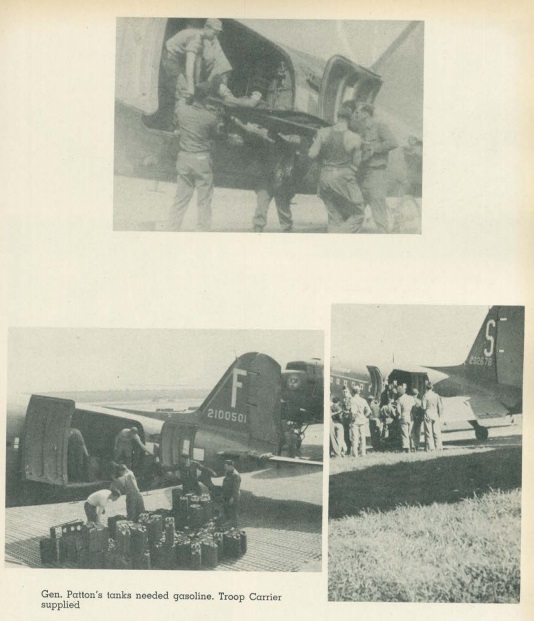
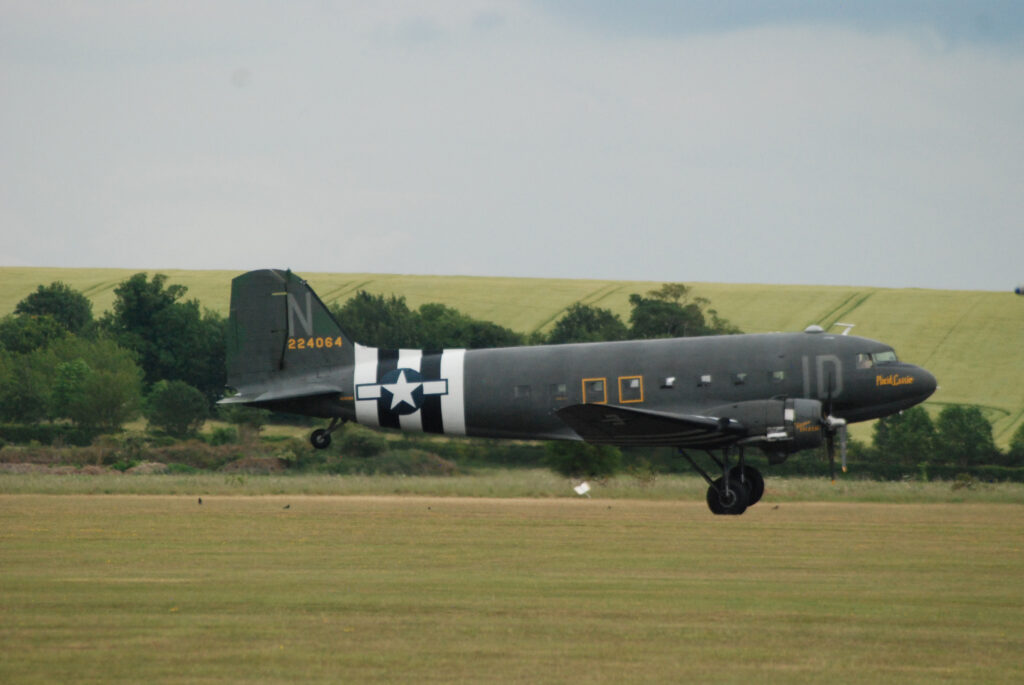
Market Garden, September 1944
Sunday September 17th 1944 saw Placid Lassie flying to Eerde, west of Veghel in Holland, on a beautiful autumn morning. 74th TCS, serial A-6, was carrying elements of 2nd Battalion, 501st PIR of 101st Airborne to Drop Zone ‘A’ and the paratroops were dispatched successfully at 13:06. The forces dropped by the Aldermaston squadrons were successful in capturing the four bridges at Veghel.
The following day, the 74th TCS was back in the air as part of the lead serial A-35 along with the 72nd TCS’s 42-68830, D-Day Doll. This time, they were towing Waco gliders for 101st Airborne to Landing Zone ‘W’ close to Son. Although 72nd TCS lost two aircraft, the 74th escaped unscathed.The autumn weather began to deteriorate on 19th as the 74th took to the air in the late morning towing gliders in the sixth of ten serials. They headed east into very low cloud with visibility so poor that the gliders were frequently unable to see the tug aircraft. Their destination, once again, was LZ ‘W’ at Son and despite the weather issues and fairly intense flak, Placid Lassie’s serial, A-78, released the gliders successfully over the target at 15:45. During the operation, Placid Lassie’s former second pilot, 1st Lt. Ralph Lundgren, was killed when the C-47 he now commanded crashed.
On 20th September, 74th TCS was allocated a re-supply mission and transported ammunition and other essentials to the 82nd Airborne at DZ ‘O’ to the south of Nijmegen. The 74th TCS was back in the air on September 23rd when gliders were towed to reinforce the 101st Airborne. Poor weather continued, but the final Market Garden operation for 74th TCS was completed on September 26th with a return to DZ ‘W’ to drop artillery shells to the 101st.
In the days following Market garden, the 434th TCG continued with casualty evacuation and logistical support. The end of 1944 brought a further setback for the allies with von Runstedt’s tank offensive through the Ardennes. The ‘Battle of the Bulge’ saw US forces surrounded at the strategic transport centre of Bastogne. Poor weather precluded re-supply until December 23rd when the 74th TCS flew the first of three missions to drop essentials to their old friends, the 101st Airborne. No aircraft were lost.
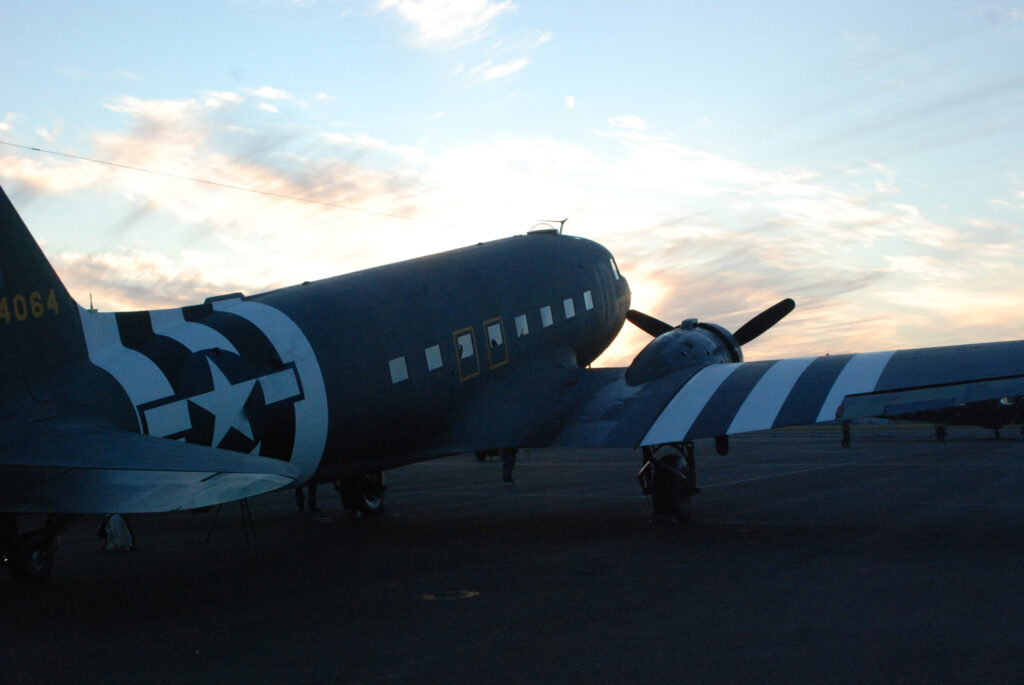
1945
In Spring 1945 the 434th moved from their established home at Aldermaston to an advanced base at Mourmelon, A-80, close to Reims in Northern France. This was a precursor to Operation Varsity, the Rhine Crossing, which took place on 23rd March 1945. On this huge and very successful mission, Placid Lassie was the last aircraft in serial 2 bound for Landing Zone ‘X’ at wesel with troops of the 17th Airborne Division and elements of the Division Artillery HQ. Not all of the 17th Airborne landed where they should; poor visibility caused by an allied smoke screen led to some ‘deliveries’ to a British rather than American landing zone and the 17th had to ride to their targets on British Churchill tanks.
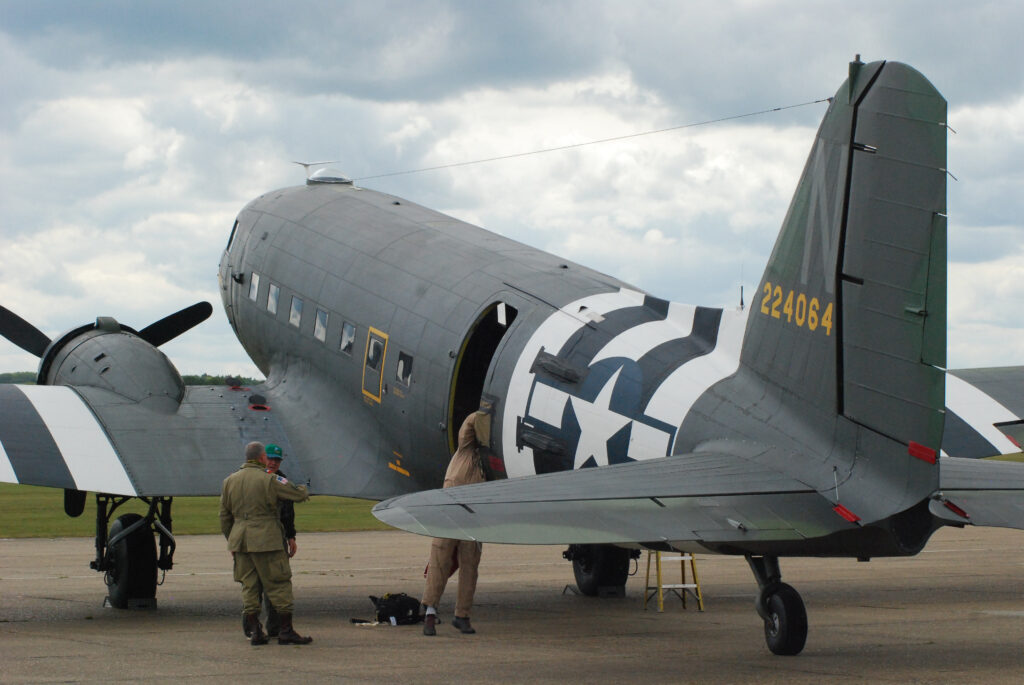
1945
The phase after Operation Varsity was very busy for 74th TCS with fuel and food supplies keeping the C-47s fully employed. Flights were very close to the rapidly-moving front line and the evacuation of wounded soldiers and freed prisoners of war filled return flights to Mourmelon. Unfortunately for Placid Lassie, her part in this was curtailed on April 5th 1945 at the forward air base Y-67, Gelnhausen, just to the east of Frankfurt. The Lassie and another C-47 were damaged at this grass airstrip when a taxiing C-47 of 72nd TCS slid on the muddy surface and ran in to them. Following inspection during the next 5 days, a new wing was fitted and the aircraft pronounced fit to fly. Returning to Mourmelon on 10th April, Placid Lassie was back on operations the following day (5).
World War 2 finished with VE Day on May 8th 1945 and the 434th TCG began to prepare for return to the USA. Placid Lassie had been equipped with two new engines ready for the flight and the 74th departed on June 22nd 1945. The transit via the southern route took around 14 days with stops at Marrakesh, Dakar, Robertsfield in Monrovia, Ascension Island, Natal in Brazil, Atkinson Field in British Guiana, Belem in Brazil, Puerto Rico and, finally, Hunter Field, Savannah, Georgia. The Squadron arrived around July 6th and, after a well-deserved spell of leave, the air echelon reassembled at Baer Field and remained there until 20th August, 5 days after VJ Day. Elements of 74th TCS moved back to Alliance Field, Nebraska, and then on to Laurenceville, Illinois, in October 1945 but most of the original personnel had been demobbed and many of the aircraft sent for disposal.
(5) Detail on Placid Lassie’s post-Overlord operations is largely from a post on the facebook site airbornetroopcarrier for April 16th 2018. The site contains much fascinating information.
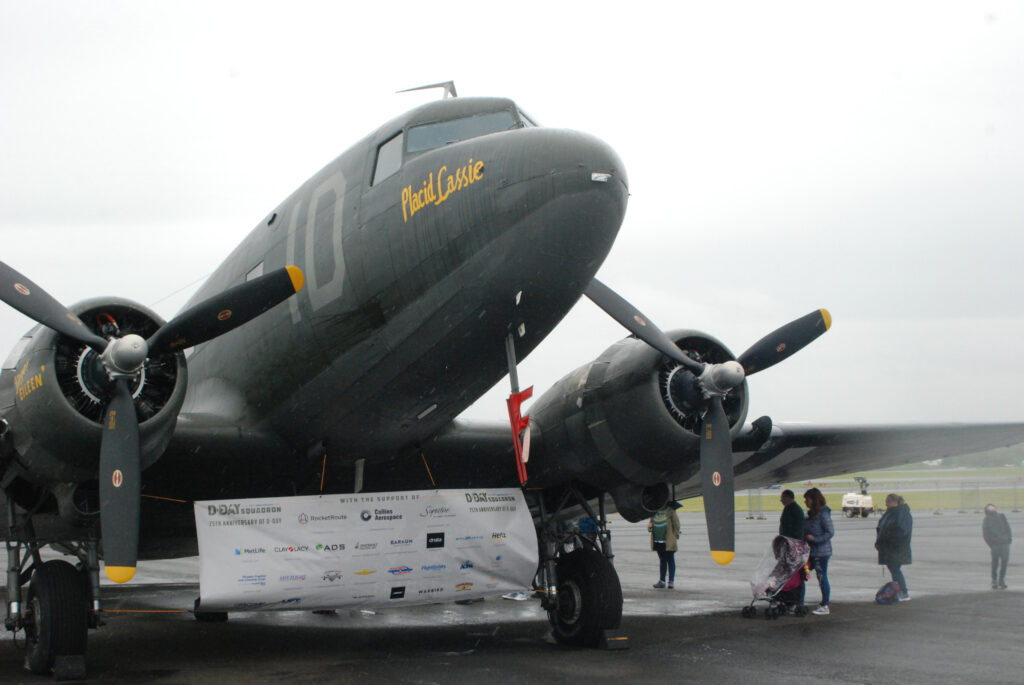
Demobilisation:
Placid Lassie seems to have briefly joined the 81st Troop Carrier Squadron upon her arrival at Hunter Field but transferred a week later on July 14th 1945 to San Bernardino, California, for storage. 42-24064’s next move was to the Reconstruction and Finance Corporation’s air base at Walnut Ridge, Arizona on 19th November 1945. She was parked up in the desert for over a year before sale to the non-scheduled air carrier NATS Air Transport Service of Oakland, California, on 6th December 1946 as NC74589. NATS had been incorporated on 23rd July 1946 to operate freight and passenger services on the west coast and also ad hoc routes to the mid west and New Jersey using DC-3s. They soon had accounting issues and fell foul of the IRS who demanded extensive back taxes. There was also a fatal DC-3 crash outside Laramie, Wyoming, in October 1948 and, during the winter of 1948/ 49, Placid Lassie was seized by the IRS and sold to her mortgage broker, Mrs Isobela Ericson, on 24/2/1949 in lieu of taxes. She sold the C-47 to Lee C.Taylor of Los Angeles on 3rd March 1948 and he, in turn, sold her to the expanding West Coast Airlines of Boeing Field, Seattle (6).
Formed back in 1941, WW2 meant that West Coast didn’t actually start flying until 1946. By then, their business model involved converting surplus C-47s to 24-seat ‘Scenicliners’ for passenger operations serving the Pacific North West. Licensed as a local service air carrier, they initially operated six DC-3s on an extensive route network which, by 1953 and their acquisition of Empire Air Lines, encompassed 32 airports focussed on Spokane, Seattle, Boise and Portland. Placid Lassie was given fleet number 106 and her registration would have been shortened to today’s N74589 as she ‘served the Evergreen Empire’ across the states of Washington, Idaho and Oregon for approaching 20 years.
(6) Basic history from Tunison Foundation site and Air Britain ‘The first 70 years’ by Jennifer Gradidge.
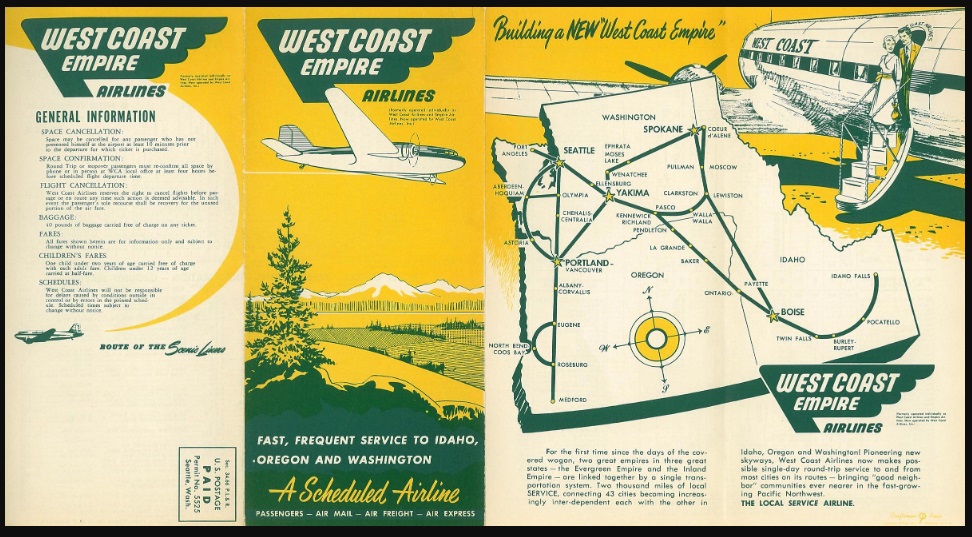
As West Coast developed, the airline added turboprop equipment in the shape of Fairchild-built F-27s followed by pure jet DC-9s and smaller Piper Navajo air taxis. In 1969, West Coast merged with fellow DC-3 operators Bonanza and Pacific Air Lines to form Air West. The C-47s didn’t fit in and they were steadily sold-off between 1968 and January 1969.
Eight of the West Coast aircraft were purchased by the Aerodyne Corporation based at Renton Field, Washington. The operation had been started in 1965 by Jack Volkel, a Northwest Airlines captain, to provide charter facilites, smoke-jumping services, maintenance, training and type-ratings on DC-3s. N74589 joined Aerodyne on June 18th 1968 (6) & (7). The company flourished for some years but, by 1974, the DC-3 fleet was parked-up at Renton and remained stored there until 1980 (7). Aerodyne is reported to have finally ceased trading in 1985 but, by then, Placid Lassie had moved on to Saber Aviation in Spring of the previous year.
Geoff Goodall’s excellent photograph of N74589 (below) was taken at Anchorage, Alaska, apparently in September 1981. However, many reports would suggest that Placid Lassie would have been parked-up at Renton in late 1981. One other explanation might be that N74589 could have joined the ranks of fellow Seattle operator Salair (8). 1981 would seem a little early for this, but Salair did eventually operate at least two other ex-Aerodyne aircraft without a change of colour scheme. Salair were clearly averse to getting the paint brush out (although it seems unlikely that they’d leave Aerodyne titles in place) and their DC-3s certainly operated in at least half a dozen colour schemes. Another Salair aircraft, N2298C, was painted with a broad royal blue cheat line very similar to that of Placid Lassie when she was bought by James Lyle in 2010. This might indicate that Placid Lassie did fly for Salair on their Alaskan fish ferry operations while in Aerodyne colours before being painted with the royal blue Salair stripe before transferring to Saber in 1984. A photo of her in Saber’s dark blue and red colour scheme would, of course, scupper this theory!
(7) From www.joebaughter.com. Some sources give the transfer date to Aerodyne as June 10th 1968.
(8) Salair was formed in 1980 by brothers Bruce and Paul Salerno who bought a southern Californian DC-3 advertised in the Trade-a-Plane newspaper. The initial plan was to ship Alaskan fish to Seattle markets. The short summer season gave the shoestring operation plenty of time for winter overhauls and, by year 3, they had acquired a second C-47. their operations expanded to include parcel delivery for UPS, Emery Air Freight and the US Postal Service and their fleet eventually expanded to 12 aircraft. Information from www.joc.com.
Saber Cargo Airlines operated from Douglas International Airport, Charlotte, North Carolina for many years with up to half a dozen DC-3s until they finally ceased operations in 2003. Much of their business involved overnight motor part delivery for organisations such as Ford, Chrysler and Caterpillar. In their later years, Saber Aviation’s owner, Mike Dockery, added jet equipment which proved expensive to run and harder to service than the ever-reliable C-47s (which is not to say that Saber’s C-47s didn’t suffer from engine issues at times…). September 11th added to the airline’s financial difficulties and they filed for Chapter 7 bankruptcy reputedly owing several million dollars (9).
(9) www.airlineforums.com reported that Saber were resuscitated under the ownership of a Charlotte aircraft broker. Mike Dockery continued to own some historic flight C-47s and had some influence in the new operation. The new name of the company was First Flight Out and they operated a former Saber C-47 which was once flown by 233 Squadron RAF. N12907 had joined Saber in April 1995 and was badly damaged in a September 2000 undercarriage collapse at Charlotte. The aircraft was transferred to the Carolinas Air Museum and remains preserved there. Placid Lassie had departed the Company during an earlier financial upset; the National Bank of North Carolina, presumably the mortgage holder on N74589, claimed that loan terms had been breached on 1st June 1989 and the aircraft was repossessed on 13th May 1990.
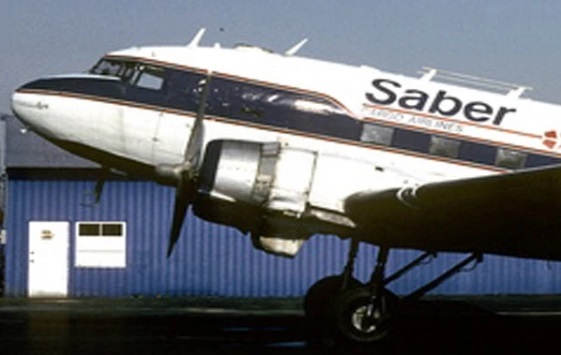
The Bank sold N74589 to Jurmie E.Watkins of Express Air Inc of Simpsonville on 24th June 1991. Express Air operated from the Donaldson Centre airfield near Greenville in South Carolina and had been formed on 16th March 1990. Express carried-out some upgrade work on the instrumentation, freight floor and engines and operated Placid Lassie to Michigan, around the eastern seaboard of the USA and as far south as Central America. The actual ownership of the aircraft seems to have been switched around with Express Air recorded as the owner from 10th August 1992 and Denis Mount/ Jurmie Watkins also listed as joint owners. Express Air went out of business in March 2000 and, by then, N74589 had been leased, possibly sold, to Dodson International Air who would take her to Covington, Georgia – a destination which came close to being her last home.
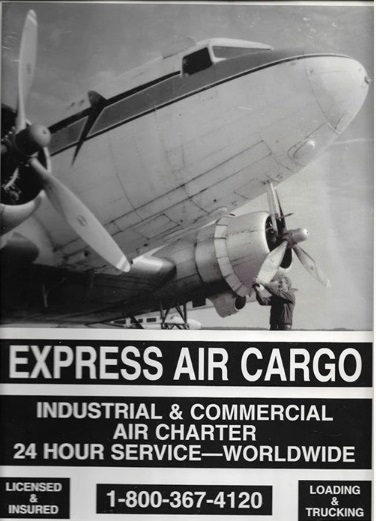
Dodson were an on-demand charter cargo airline operating under part 135 regulations and had been in operation since 1987. Placid Lassie joined in February 2000 as the Dodson fleet grew to four C-47s. Engine issues prevailed with Placid Lassie and a court action was commenced against Express Air management (10). Insufficient finance precluded the repairs and the aircraft sat at Covington for the best part of ten years while legal procedures rumbled on.
(10) According to the Covington News, July 2010, the case was brought against Georgetown Aero.
She was reportedly for sale for $100,000 in early 2003 but their were no takers. Eventually, ownership of the aircraft was handed to Dixie Jet Services, the operator of Covington, on 10th March 2008. Dixie also managed to retrieve the engines and entered negotiations to sell the aircraft to a Belgian air museum. However, by 2010, this, too, had fallen through and Dixie Jet were due to be terminated as the airport operator at Covington. Things looked bleak for Placid Lassie but, fortunately, rescue was imminent in the form of British financier James Lyle and Dakota expert Clive Edwards of DB Aviation, Welling, Kent.
After several years of sitting in the grass at Covington, Placid Lassie was looking the worse for wear. In 2007, it had been reported that renovation work was ongoing but progress remained slow or non-existent. The engines had been removed and various other parts had been liberated over the years; she looked far from airworthy. Luckily, James Lyle, an Englishman in New York, was looking for a Dakota to restore to flying condition for the EAA Airventure air show due to commemorate the 75th anniversary of the first flight of the DC-3. James had pursued a successful career in finance and was co-founder and Chief Investment Officer of the fund management company Millgate Capital Inc. Although finance may have its ups and downs, he no doubt had adequate funds to purchase a good example of a C-47 and, to this end, enlisted aviation engineer and fellow Briton Clive Edwards. Together, they assessed the potential of various DC-3 survivors across the Caribbean, North and Central America. Many of the contenders were in poor condition, but James Lyle had the money and the ambition, Clive Edwards the ambition and the experience. The Edwards Brothers were no strangers to operating in the USA, having worked on the ex-Pima EC-121T Warning Star for Yanks Air Museum. Clive Edwards had also been extensively involved in the Vickers Vimy replica which had been built to commemorate Alcock and Brown’s first transatlantic flight. In June 2009, Clive and ex-British Midland pilot John Dodd had flown the Vimy from Duxford to Clifden and then Galway Airport in Ireland before returning to Fairoaks and Duxford. John Dodd was also the Chief Pilot for the Brooklands Air Museum and he and Clive flew the Vimy on its last flight from Duxford to Brooklands on 15th November 2009. So, by Spring 2010, Edwards and Dodd were ready for a new project and, in April 2010, visited Covington to assess the condition of Placid Lassie. The challenge was daunting, but the two spent three days stripping-off inspection panels to examine the old Dak. They were unaware of her illustrious history but reported that her condition was much better than anticipated. By May 13th, Dixie Jet Services had sold N74589 to the Wells Fargo Bank, agents for James Lyle.
With no logbooks to document the aircraft’s maintenance history, Edwards and his fellow mechanic Gordon Grey had to strip the aircraft down and follow every relevant service bulletin and maintenance directive during the reconstruction. Once dragged out of the weeds, the team raised a Union Jack on the old C-47 and, as their determination to get the aircraft back in the air became apparent, Georgia locals soon began to identify her as the ‘Union Jack Dak’. With only eight weeks to the planned appearance at Oshkosh, the pressure was on as wings were removed, fuel tanks extracted and all flexible hoses renewed. Replacement engines were fitted and, with just over a week to spare, Placid Lassie took to the air again on her first test flight. The triumph of seeing her back in the air was soon shattered by a major failure in the port engine. The P&W was promptly shut-down to avoid further damage and the flight was brought to a swift conclusion. For a moment, it looked like the Oshkosh deadline would be missed but fortunately, with James Lyle’s resources behind the project, a zero hours Twin Wasp was on its way to Covington within 4 hours. Forty hours hard work ensued to install the engine, repair and flush oil lines, change the oil cooler and remedy other identified faults. N74589 had originally been due to visit the ‘Last Time’ meeting at Rock Falls prior to Oshkosh but this was no longer feasible. On the last Tuesday before the EAA meeting, Placid Lassie took off from Covington en route to Wisconsin. Initially, she landed at Fond-du-Lac airport, a short hop from Oshkosh but, on the Wednesday morning, she transferred to Oshkosh still wearing her rather tired blue and white colour scheme but with the Union Flag proudly flying. The short-term restoration had been what Clive Edwards had planned and was testament to his experience working with 30+ other Dakotas as well as the resilience of the Douglas design. The team clearly meant it when they painted the slogan on the nose ‘No sleep til Oshkosh’.
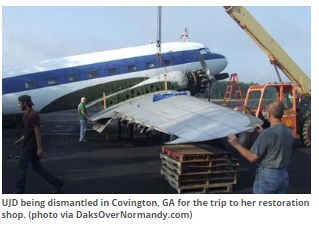
Following the successful showing at Oshkosh, Placid Lassie travelled to Oxford Waterbury Airport and, by the following summer, 2011, she had been returned to USAAF camouflage colours, complete with invasion stripes, and outfitted with a couple of rows of Boeing 727 seats. James Lyle and Clive Edwards original plan had been to sell her immediately after Oshkosh but she had performed well during early flights and they decided that a new challenge would be for her to cross the Atlantic to take part in the ‘Daedalus 70th anniversary of D-Day’ fly-in at Lee-on-Solent in Britain. Still labouring under the ‘Union Jack Dak’ moniker, she departed Waterbury on May 6th 2014 with a crew comprised of two Britons, two Americans, one Frenchman, one Argentinian and one French-American. Heavy fuel consumption during the initial stage led to an unscheduled stop to replace a carburettor. Following that, her route included Goose Bay, Narsarsuaq, Reykjavik and Prestwick before landing at Coventry on May 10th – a fine rehearsal for the 2019 event. N74589’s stay in Coventry was supported by Air Atlantique and, during her spell there, she made a side trip to Duxford for the D-Day anniversary show on May 24th and 25th. The Lee-on-Solent event took place between 2nd and 4th june and N74589 was in the air on June 2nd having travelled further than any other aircraft to participate in the flying. The event itself was slightly marred by the lack of public access permitted at Lee-on-Solent but the town put on an excellent set of commemorative festivities with many of the locals dressing the part of WW2 soldiers, land girls, civilians and school children. N74589 was in the air again on June 3rd for a ‘poppy drop’ following a commemorative service at the Lee War Memorial.
Photos of the event, including Placid Lassie’s flypast, can be found at www.solentaviatrix.wordpress.com/2014/06/
In Coventry, a static parachute line had been installed to enable parachutists to take part in a mass memorial jump at Carentan, Normandy on June 4th. N74589 went on to participate in the Farnborough International Air Show on 17th and 18th July 2014 before going to Holland for commemorative flights over the Maas Bridge at Grave to mark the 70th anniversary of the Market Garden operation. It was during the Normandy flights that the C-47 had been visited by Dutch DC-3 expert, Market Garden historian and author Hans den Brok. He knew the history of 74th TCS and recognised the ‘Union Jack Dak’ as being the C-47 crewed by Radio operator Ed Tunison. He was able to connect the retired airman with the current operators and, in September 2014, Ed Tunison and his son flew to Belgium to see the aircraft they had known as ‘Placid Lassie’ one more time. He was able to give pilot Eric Zipkin the story behind the C-47s name and the titles for the engines: Idling Ida and Eager Eileen (Mrs Tunison).
Ed Tunison died in 2016 and James Lyle decided to donate the aircraft to a 501c3 charitable foundation named after Ed. ‘Placid Lassie’, as she had now become again, had been operated under the auspices of Eric Zipkin’s Tradewinds organisation but, in 2017, she passed to the ‘Tunison Foundation’ which, in turn, became the inspiration for the whole D-Day Squadron operation.
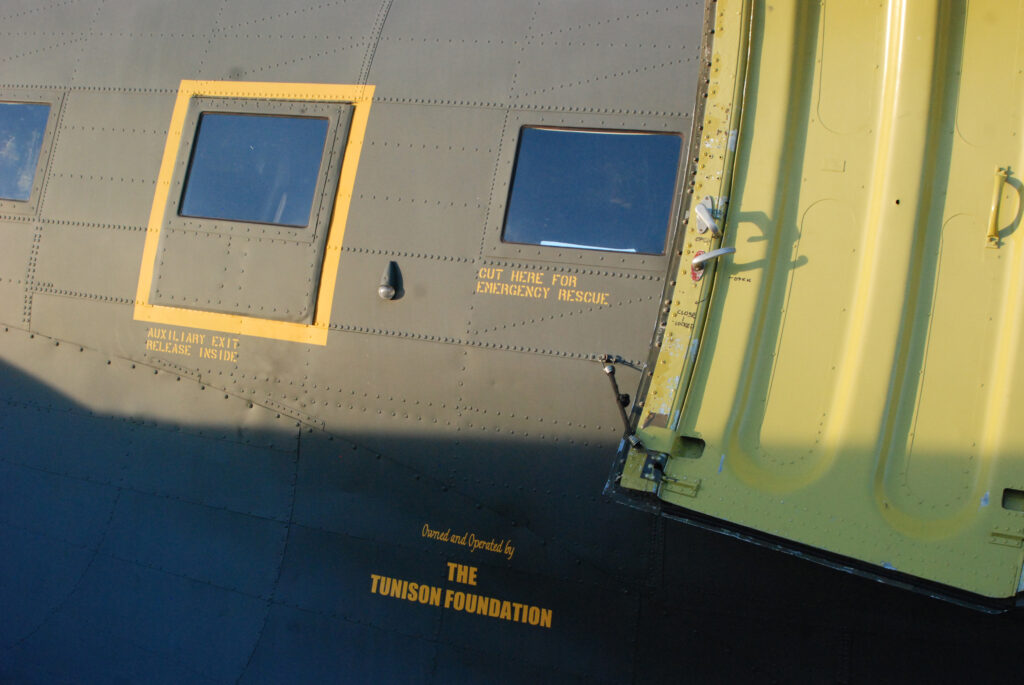
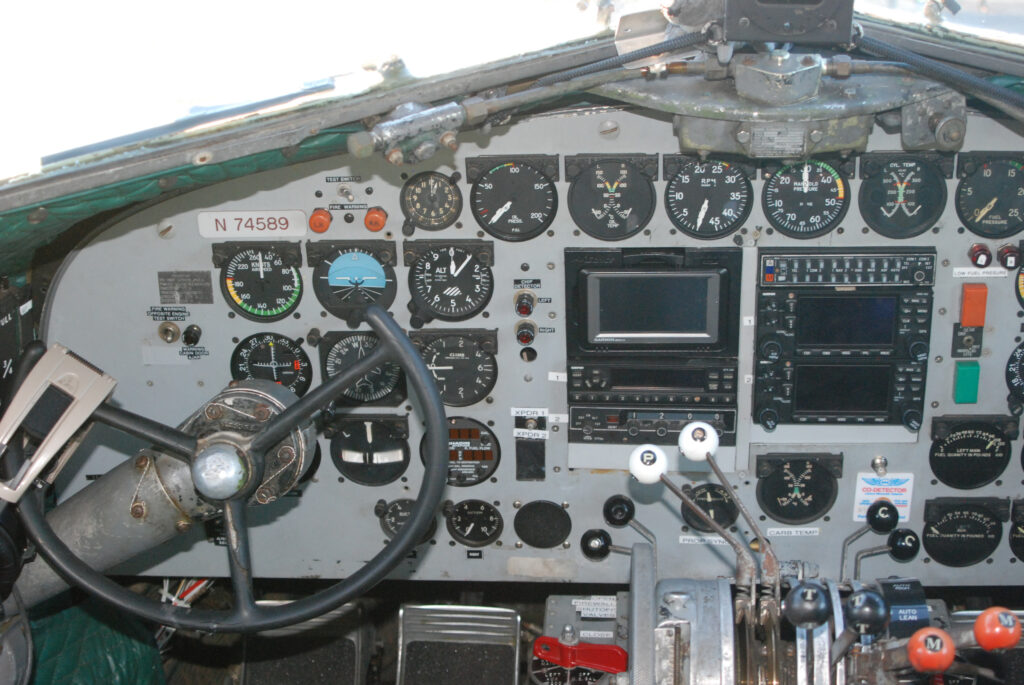
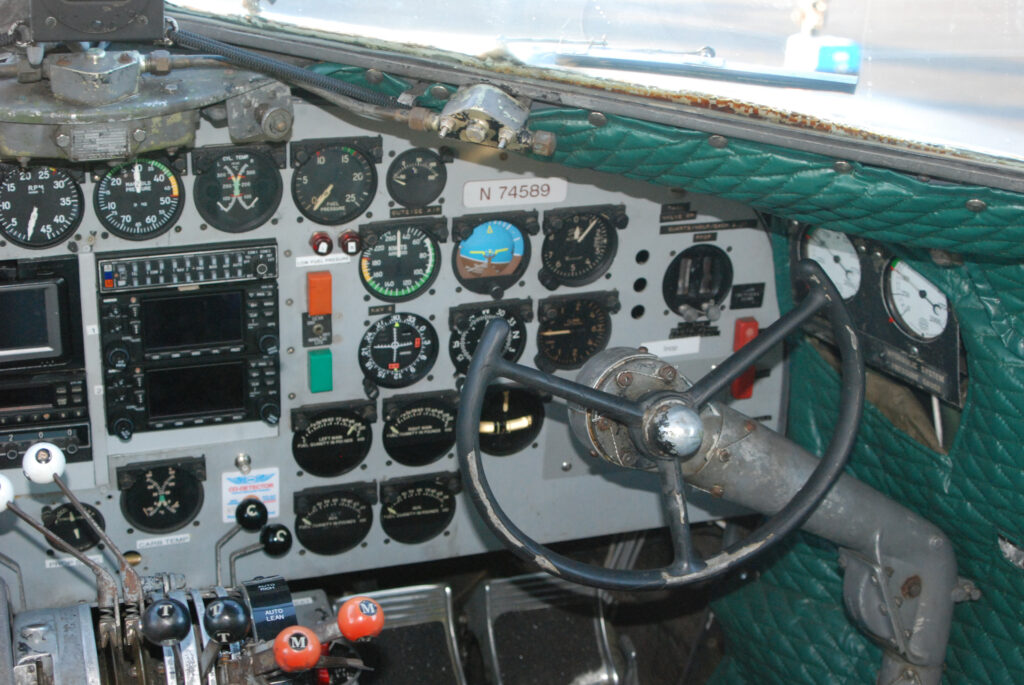
Placid Lassie’s Route to D-Day 75th Anniversary commemoration
On 9th May 2019 Placid Lassie was at Thomason, Georgia. The following day Eric Zipkin flew her to the AOPA Fly-In at Frederick, Maryland. Following an overfly of Arlington Cemetery on 10th May and practice paratroop drop, the DC-3 went on static display on 11th May.
Placid Lassie was then flown to Oxford Waterbury Airport , Connecticut, on May 14th for the 5 days of preparations for the D-Day Squadron Atlantic crossing.
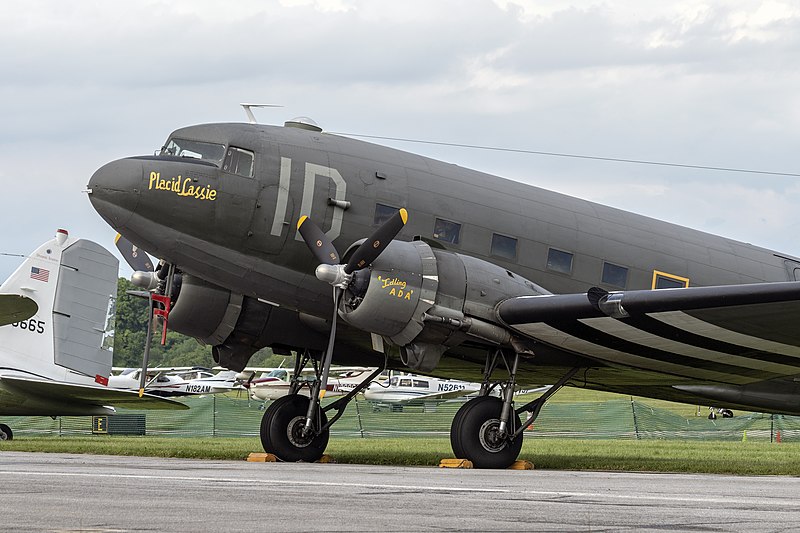
Placid Lassie’s Route to D-Day 75th Anniversary commemoration
Placid Lassie was part of the ten aircraft contingent which departed Waterbury on Sunday May 19th 2019 for the two and a half hour sector to Presque Isle. N74589 was second to last off the ground at 09:11 and, after a couple of hours on the ground in Maine, she was en route again to Goose Bay, the gateway to the Blue Spruce Route.
The next leg was commenced on the morning of May 20th with five of the D-Day Squadron complement departing Goose Bay on their way to Reykjavik. Miss Virginia led four C-47s to Narsarsuaq and then on to Reykjavik while Placid Lassie chose to fly the 1500 miles to Reykjavik in one session – a 10 hour sector, ending at 20:30 GMT. After a days rest in Reykjavik, four of the D-Day Squadron departed for Prestwick on the longest sector of the journey. Observers in the Outer Hebrides were treated to hearing the first three Dakotas passing overhead in the early afternoon and Miss Virginia touched-down at Prestwick at 14:19 BST, Placid Lassie at 15:00 and That’s All Brother at 15:39. Liberty arrived a couple of hours later.
Following the Prestwick Open Days on May 24th and 25th, Placid Lassie departed for Duxford at 14:16 BST on Monday 27th and arrived at Duxford at 16:16. On June 1st, Placid Lassie was one of the seven D-Day Squadron C-47s which squeezed into the Shuttleworth Collection’s grass airstrip at Old Warden.
June 3rd and 4th were open days at Duxford, followed by the mass departure for Normandy on the afternoon of June 5th. Operations for the next few days were from Caen Carpiquet, with a ground display on June 7th. Parachute jumps were carried-out at La Fiere on June 9th before Placid Lassie departed for Wiesbaden that same evening. Together with D-Day Doll, Placid Lassie completed a fly-by of Bastogne to commemorate the Battle of the Bulge. Following the very successful air days at Wiesbaden, the C-47s were due to depart on June 12th for a series of flyovers of German airfields prominent during the Berlin Airlift. Poor weather delayed the departure but, on May 13th, perfect weather facilitated the mass take-off by eighteen C-47s. Placid Lassie was part of the formation which flew north to Hannover Langenhagen Airport before separating into two groups which landed at Jagel and Nordholz respectively before continuing to Fassberg. Placid Lassie then took part in the 16th June Berlin flyover to commemorate the Berlin Airlift before landing back at Fassberg. The ‘Candy Bomber’ Gail Halvorsen was in ‘Miss Virginia’ for the Berlin flypast but had earlier taken a flight in Placid Lassie too. He took the opportunity to add his signature to the olive drab inside fuselage of Placid Lassie.
By June 18th, Lassie was at Tannheim, Germany, where she remained until departing for Venice/ Nicelli Airport at 08:11 June 21st., arriving at 10:07. After two days at Venice, N74589 was the first of the four aircraft to depart, starting her long return home to the USA. On June 23rd she stopped over at Berne in Switzerland before heading west, back to Coventry in the UK. By 26th June she was in company with ‘That’s All Brother’ at Prestwick before departing the following day for Reykjavik. On 28th June the two C-47s were on their way across Greenland and Placid Lassie made it to Goose Bay, Labrador, that afternoon. On 29th June, Placid Lassie flew on to Bangor, Maine – the last stop before reaching Oxford Waterbury. The next big event was the EAA Fly-in at Oshkosh where she arrived on 20th July 2019. The Airventure event on 27th and 28th culminated in Placid Lassie being voted the ‘Peoples Choice’ .
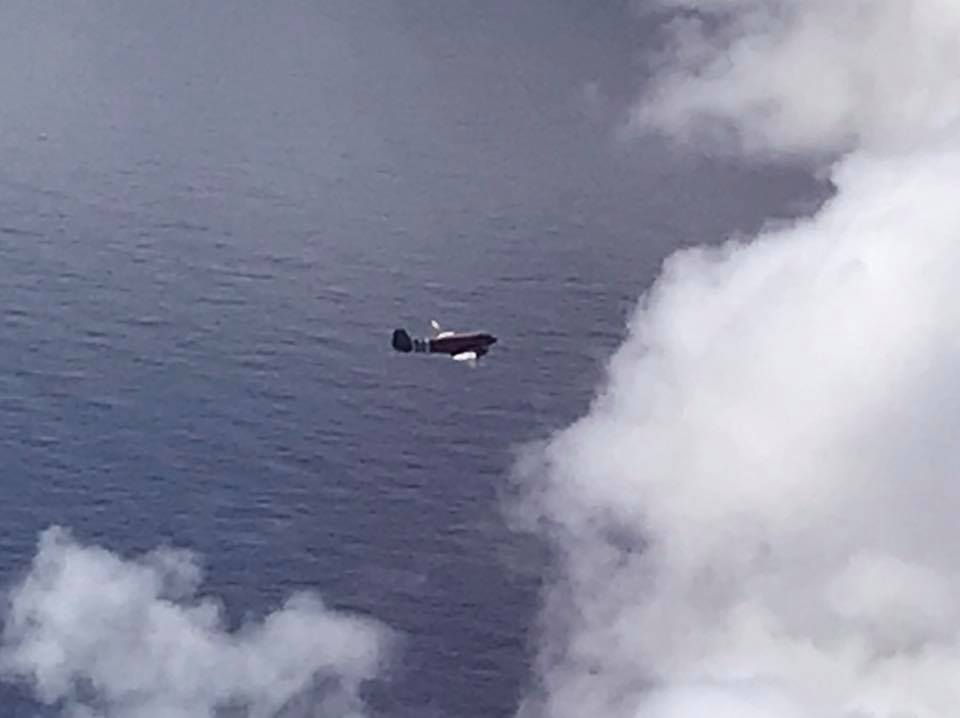
Hits: 1101
